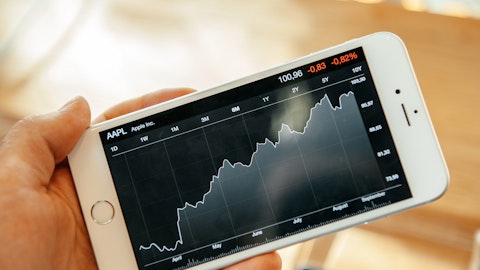Mike Dastoor: And, David, from a buyback perspective, you’re absolutely right. We’re going to try and get the whole $2.5 billion done this year. That not only has a positive impact on WASO in FY ‘24, I think we’ve said 124 million to 127 million WASO by the end of ‘24. And then for FY ‘25, we’ll have a normalized buyback program. And if you look back at our history over the last six, seven, eight, 10 years, we’ve done about $500 million a year. So, it will be safe again. We don’t have the authorization from the Board yet for that FY ‘25. It’s early days. But I’d expect that to be in that $500 million range. And when you add all the early buybacks in ‘24 plus that our WASO goes down to $110 million to $115 million depending on share price, so it is the best use of our funds.
And I keep saying that with our history, what we’ve done over the last few years proves that out, that we’ve been — we put our money where our mouth is, and we will continue to do so as we feel we’re still highly undervalued.
David Vogt: Great. And can I just make a quick follow-up? I think, Mike mentioned lower interest rates could have a stimulative effect on the business. Maybe, Kenny, if you can kind of help us think about where do you think the most impact could be felt by end market, which is the most sensitive to rates? Given your mix, I would imagine more of the…
Kenny Wilson: Renewables for sure.
David Vogt: Right, exactly.
Kenny Wilson: Yes. Renewables for sure. I mean, if we look at our — we’ve developed a — developing really great capabilities in the renewable space and we’re kind of just waiting for things to bed down and guidance from — through with the IRA. But also interest rates for sure are impacting solar rollouts in the residential space. So, I would say, out of all of our businesses — auto will help us also, obviously, and — but I think renewables would be the number one. We would expect to see a tailwind there.
Mike Dastoor: I would also expect some level of enterprise level spend to improve. I think, a lot of CFOs have been pulling back on purchases, enterprise level purchases, with interest rates going down. And just the whole macro environment changes on that perspective. So, we do expect other end markets to have an impact. Will it happen immediately? Probably not, but over time it will have a positive impact for us and for almost every other company as well.
David Vogt: Got it. Thanks, guys.
Operator: Thank you. Our next question is coming from Melissa Fairbanks from Raymond James. Your line is now live.
Melissa Fairbanks: Hey, guys, thanks very much. Talk about getting in under the wire. I’m curious about the comment that you’ve made or the comments that you’ve made on supply chain consolidation in renewables. I know supply chain services, this is one area that’s driving more, like, direct customer engagement in your business overall. So, in renewables, are you working directly with these customers managing their supply chain, or is this consolidation happening further downstream?
Kenny Wilson: Yes. Hey, Melissa. So, I would disconnect the two a little bit. So, what — there’s been some announcements from us on supply chain services. We just had our supplier summit actually yesterday and today, which has been fabulous to meet with our suppliers. We’ve been talking supply chain services for a long time and we’re just putting the building blocks in place to make that material for us in the longer term, but obviously to support our customers. In terms of supply chain consolidation, what we’re finding is that, and it goes back to, I think, pre-COVID, where the world thought that supply chain diversification was good. So, have multiple suppliers be dual sourced. And then people found out that that was hugely difficult to manage.
So, when you get dislocations like this, our customers are thinking, how can I simplify my life? How can I simplify my world? I mean, people look at our inventory relative to our peers and they’re saying, well, maybe that’s an indicator of that I should be safe with Jabil. And what we see is just discussions around, look, can you — can we — can you manage my supply chain? Can you build it in your sites? It gives me less people to engage with as long as you can trust it and you can deliver. So, it really is that and dislocation that’s driving those discussions and that’s happened. If I look at other times like this, that — what we’ve found has been good for our business if you look at the pre to post-COVID. So, we do expect that this will be good for us also in the longer term.
Melissa Fairbanks: Okay. All right. Great. Maybe as a follow-up. I’m glad you mentioned silicon photonics a couple of questions ago. I think, this acquisition is really interesting in terms of adding value, but we haven’t really talked about it a lot. Does the acquisition of the Intel silicon photonics business, does this bring any revenue along with it, or is it simply about bringing in more of the supply stack internally, and it’s already kind of reflected in your business? And then longer term, does this provide more of a competitive moat in AI?
Kenny Wilson: Yes. So, for sure, let me talk about the — let me just give you a little bit of background on that and then talk about what we’re doing. We did an acquisition in 2014 of optical business, a small optical business with a tuck-in capability like we do. And we’ve been gradually building that. And the key for us was it was in the telco space, but it was always going to be focused on the datacom space in the longer term, that’s where we’ve seen the value. So, we’ve been growing that capability. It’s not hugely material for us, but the capability is something that we think we can develop. So, this Intel opportunity is, it really came out of a discussion with our cloud providers where they’re looking for us to — they’re looking to disaggregate supply chains and want us to be more vertical.





